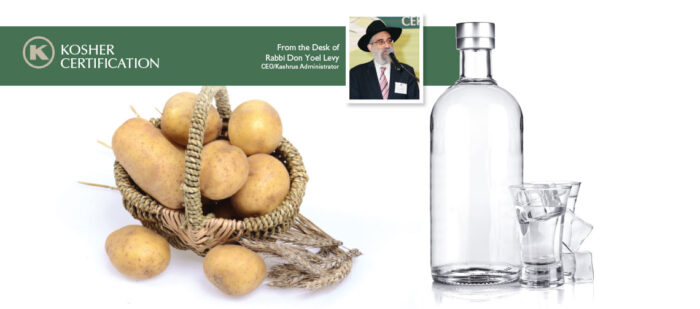On Simchas Torah, Jews throughout the world conclude—and then begin again—the annual cycle of the reading the Torah, remembering the original Kabbolas ha’Torah (the receiving of the Torah) on Har Sinai. Chaza"l tell us that, at that pivotal moment, Hashem suspended the mountain above their heads "like a keg of beer" and admonished them: "If you accept the Torah, you have done well; and if not, I will drop mountain on top of you and this will be your grave."
Chaza"l explain that, although the Jewish people had already willingly accepted the Torah (by saying Na’aseh v’Nishma—we will do and we will listen), Hashem wanted to ensure that they realized that accepting the Torah is not a voluntary contract, one that could chas v’sholom be rescinded at will. The use of a "keg of beer" as a metaphor should not, however, go unnoticed. Beer offers many important insights into halacha and kashrus and, as we shall see, has been drunk for thousands of years—even on Pesach!
Beer is but one form of the untold number of fermented beverages devised by man to slake his thirst and revive his spirit. It is the world’s most popular alcoholic beverage and, indeed, the English word "beer" comes from the Latin bibere—to drink! But to understand beer, we must first understand alcoholic beverages in general. All alcoholic beverages are produced in essentially the same manner—by converting a sugary liquid into alcohol through a process called fermentation. In this case, the fermentation involves a single-celled fungus called yeast (zymose in Greek), which works its magic by secreting an enzyme (zymase) that converts sugar into ethanol and carbon dioxide. The difference between various alcoholic beverages is merely the source of the sugar. For example, if we start with grape juice, we call the resulting fermented beverage "wine." If we start with apple juice, we call it "cider," and if we start with honey we call it "mead." But what does one ferment when sugar is not available? The solution is to convert something else into sugar.
The Talmud (P’sachim 107a) records four different types of beer, which are (as explained by the Rashbam): Shay’char (date beer), Pirzuma (barley beer), T’ainy (fig beer), and Asni (berry beer). They are called "beer" because the sugars are extracted from the fruit by boiling them in water—"brewing" – as opposed to squeezing the juice from them. [The term "brewing" refers to the steeping or boiling of the fruit in water, just as one brews coffee or tea.]
The problem, however, is that while brewing will extract sugar from fruit (such as dates, figs, and berries), barley contains virtually no available sugar. The production of beer from barley, which the Talmud notes is superior to fruit beer, requires an additional step called malting — the understanding of which offers a fascinating insight into how Hashem ensures the growth of seed.
A kernel of barley (or virtually any grain) is really a seed, designed to be planted in the ground and sprout into a new plant. It contains three parts—the germ (the part that actually grows), endosperm (the white, starchy mass that is the vast majority of the seed), and bran (the fibrous layer that protects it). The germ is the living part of the seed and lies dormant until it becomes moist after planting, at which point it sprouts and requires sugar for nourishment.
The endosperm to which the germ is attached contains starch molecules, which are actually very long chains of glucose (sugar) molecules. Since the germ cannot metabolize such large molecules, Hakadosh Boruch Hu gave this hungry germ the ability to produce amylase enzymes, chemicals that break the starch down into the sugars that it can readily digest. Man long ago mastered the art of malting, soaking barley in water to trick the germ into producing these enzymes and converting the rest of the grain into sugar. Brewing this malted barley yields a sugary liquid, called wort that can then be fermented into beer. In essence, beer is nothing more than grain wine.
While any type of grain can be converted into sugar, malted barley has a distinctive flavor and has historically served as the grain of choice for making beer in many parts of the world. However, beer using only fermented grain would tend to be sweet—not the bitter, astringent beer that is preferred in many cultures. To address this challenge, beer makers have historically added a variety of flavorings to their creations, such as wild rosemary, coriander, ginger, anise seed, juniper berries, and wood bark. The most popular additive, however, is the flower from a vine called hops. The Talmud (Moed Katan 12b) notes that something called "K’shusa" is used to make beer. Rashi translates K’shusa as humlin which, in turn, is translated by the M’targem as hopfen—hops. [The Romans fondly referred to hops as a vine that grew "like a wolf among sheep", and gave it the name Lupus salictarius ("the good wolf"), from which hops took its botanical name humulus lupulus.] Hops provide an astringency that serves as a counterpoint to the natural sweetness of the brew, as well as mild sedative properties. In addition, hops act as a preservative and antiseptic, a point noted in the Talmud (Avodah Zarah 31b) Traditionally, the hops flower was added directly into the beer vats, although modern technology has made it possible to extract and concentrate the hops rosin.
While any type of grain can be converted into sugar, malted barley has a distinctive flavor and has served as the grain of choice in many parts of the world.
Historically, fine European beer contained only barley, water, and hops—a recipe codified by William IV, Duke of Bavaria, in the Reinheitsgebot (German Purity Law) of 1516. Today, however, many types of beer include less expensive corn and rice, and may include some color additive (usually caramel color). While none of these ingredients poses any particular kashrus concerns, some interesting issues do present themselves.
One interesting question concerns a problem that has bedeviled beer makers for centuries. In addition to starch, barley contains a certain amount of protein, a component that is not subject to fermentation. As the beer is cooled, the proteins tend to coalesce and form a haze, destroying the clarity of the product and several processes have been developed to address this concern.
One involves the use of protease enzymes to break down the proteins—a process call chillproofing—and the need for such enzymes served as one of the primary catalysts for the development of the modern enzyme industry. Papain and bromelain, naturally occurring enzymes from the papaya and pineapple plant, respectively, were originally used for this purpose, while proteases derived through microbial fermentation are generally used today.
Another process involved the use of certain negatively charged fining agents that attract the positively charged proteins and thus clarify the product. One of the classic clarifiers used for this purpose is isinglass, a type of non-kosher fish gelatin. The process involves the addition of a small amount of this gelatin to the hazy liquid, with the gelatin attracting the haze particles and causing both them and the gelatin to flocculate and fall to the bottom. This sediment is then filtered out of the beer together with the gelatin, leaving a clear brew.
While the Nodah b’Yehuda (M.K. Y.D. 26) permits the use of isinglass—and virtually all authorities concur that any beer so made would be permitted due to the minor amount of isinglass used—the major kashrus agencies do not allow the use this or other types of gelatin to clarify beer under their certification.
Conventional beers from major manufacturers are flavored with nothing more than hops, and may generally be considered kosher, without requiring a kosher symbol on the label. This applies to both light and dark beers, as well as low-calorie versions. Beers with less conventional flavorings, however, should be avoided unless they bear a reliable kosher symbol since these flavors may pose significant kashrus concerns. Indeed, a product called Chelada® — a blend of beer and Clamato® — contains a small amount of clam juice!
Similarly, microbreweries often produce unconventional concoctions containing non-kosher ingredients, and one must ensure that even their regular brews are not compromised by such non-kosher productions. Therefore, microbrews should bear a reliable kosher symbol as well.
While beer is generally recognized as being quintessentially chometz, this is not always the case. Many of the types of beer listed in the Talmud were made from fruit, and were clearly consumed on Pesach. Indeed, "Passover Beer" has recently made a comeback by skipping the malting process entirely and using honey and molasses as the sugars, fermenting them with Passover yeast and flavoring it with hops.
One more point about beer should be noted, however. Chaza"l recognized that alcoholic beverages bring great cheer and merriment, and drinking them with non-Jews could foster a dangerous camaraderie. They therefore placed severe restrictions on wine produced or handled by non-Jews, effectively precluding such partying. These restrictions were not placed on beer, however, and one may consume beer produced by non-Jews. However, the Shulchan Aruch (Y.D. 114:1) rules that one may still not drink beer in a non-Jewish bar. While the Ramo is more lenient, one must be ever mindful of Chaza"l’s concerns in this regard.
On Simchas Torah we read the final Parshah of the Torah—v’Zos ha’Berachah, in which we find the posuk "v’hem tuku l’raglecha yisa midabrosecha". Rashi explains that this verse refers to the mountain that was suspended over the Jewish people at the time of Matan Torah and how B’nei Yisroel reacted to it. Although Hashem used the mountain as a type of coercion, the Jewish people nevertheless demonstrated their commitment to the Torah by crowding under the mountain—"tuku" from the word "toch" (inside)—and not trying to escape. We can therefore understand why Chaza"l chose the metaphor of a "keg of beer" to describe the mountain. The Hebrew word for beer is Shaychar, which contains the same letters as the word "Sachar" (reward) and, as Rashi explained, they thereby merited the receiving of the Torah.
2. Other botanicals can be used to produce beer, such as root beer and ginger ale, and it need not be fermented. For purposes of this article, however, “beer” will refer to fermented grain products containing alcohol.
3. The presence of yeast was unknown at that time, and was there not an official “ingredient”. Beer fermented due to the presence of ever-present natural yeasts. This oversight was corrected in 1857, when the Reinheitsgebot was amended to recognize yeast as a fourth ingredient.
4. Gelatin can also be used to clarify and filter fruit juices, and Kashrus organizations generally do not certify such products.
5. Some concern had been expressed that this product might contaminate other conventional beers packaged on the same line. Fortunately, this turned out not to be the case.
6. See P’sachim 8a, where Rav Chiya requires one to check his beer storehouse for chometz – clearly assuming that the beer itself was drunk on Pesach!
Rabbi Zushe Yosef Blech


 EN
EN  ZH
ZH  KR
KR  BR
BR  ES
ES  IN
IN  IL
IL 


